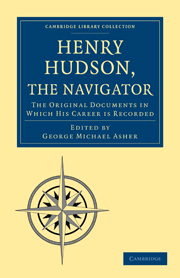Book contents
- Frontmatter
- Contents
- Introduction
- Notes to Introduction
- DIVERS VOYAGES AND NORTHERNE DISCOVERIES
- Divers voyages and northerne discoveries of that worthy discoverer Henry Hudson, from Purchas' Pilgrims, vol. iii, pp. 567-610
- A larger Discourse of the same Voyage and the success thereof, written by Abacuk Pricket
- A note found in the deske of Thomas Wydowse, student of mathematics, one of them who was put into the shallop
- Purchas his Pilgrimage, folio, London, 1626, p. 817. VI. Of Hudson's discoveries and death
- Hudson's first voyage (1607), from Edge's brief discoverie of the Muscovia merchants
- Captain Fotherby's statement concerning Hudson's Journal of his first voyage
- Hudson's third voyage (1609) from Van Meteren's Historie der Nederlanden. Folio, Hague, 1614, fol. 629a
- Extracts relating to Hudson's third voyage (1609), from John de Laet's Nieuwe Werelt, fol., Amsterdam, 1625, 1630-1
- Extracts containing some original information about Hudson's third voyage, from Mr. Lambrechtsen van Ritthem's ‘History of New Netherland’
- Extracts concerning Hudson's third voyage (1609), from Adrian van der Donck's ‘Beschryvinge van Nieuw Nederlandt,’ 4to., Amsterdam, 1655, 1656
- American traditions concerning the third voyage (1609)
- An Extract from Captain Luke Foxe's description of Hudson's fourth voyage (North-West Fox) p. 70
- Hessel Gerritz's various accounts of Hudson's two last voyages, from the Latin and Dutch edition of the ‘Descriptio et Delineatio Geographica detectionis Freti ab H. Hudsono inventi.’ Amst., 1612, 1613: I. Hudson's fourth voyage. A summary printed on the back of the chart. An account of the voyage and new found strait of Mr. Hudson
- APPENDIX
- Index
- Plate section
Extracts containing some original information about Hudson's third voyage, from Mr. Lambrechtsen van Ritthem's ‘History of New Netherland’
Published online by Cambridge University Press: 05 August 2011
- Frontmatter
- Contents
- Introduction
- Notes to Introduction
- DIVERS VOYAGES AND NORTHERNE DISCOVERIES
- Divers voyages and northerne discoveries of that worthy discoverer Henry Hudson, from Purchas' Pilgrims, vol. iii, pp. 567-610
- A larger Discourse of the same Voyage and the success thereof, written by Abacuk Pricket
- A note found in the deske of Thomas Wydowse, student of mathematics, one of them who was put into the shallop
- Purchas his Pilgrimage, folio, London, 1626, p. 817. VI. Of Hudson's discoveries and death
- Hudson's first voyage (1607), from Edge's brief discoverie of the Muscovia merchants
- Captain Fotherby's statement concerning Hudson's Journal of his first voyage
- Hudson's third voyage (1609) from Van Meteren's Historie der Nederlanden. Folio, Hague, 1614, fol. 629a
- Extracts relating to Hudson's third voyage (1609), from John de Laet's Nieuwe Werelt, fol., Amsterdam, 1625, 1630-1
- Extracts containing some original information about Hudson's third voyage, from Mr. Lambrechtsen van Ritthem's ‘History of New Netherland’
- Extracts concerning Hudson's third voyage (1609), from Adrian van der Donck's ‘Beschryvinge van Nieuw Nederlandt,’ 4to., Amsterdam, 1655, 1656
- American traditions concerning the third voyage (1609)
- An Extract from Captain Luke Foxe's description of Hudson's fourth voyage (North-West Fox) p. 70
- Hessel Gerritz's various accounts of Hudson's two last voyages, from the Latin and Dutch edition of the ‘Descriptio et Delineatio Geographica detectionis Freti ab H. Hudsono inventi.’ Amst., 1612, 1613: I. Hudson's fourth voyage. A summary printed on the back of the chart. An account of the voyage and new found strait of Mr. Hudson
- APPENDIX
- Index
- Plate section
Summary
The inclinations of the directors of the East India Company were much at variance upon the proposals of Hudson. The directors of Zealand opposed it; they were probably discouraged by the fruitless results of former voyages, concerning which they could obtain sufficient information from their colleague, Balthasar Moucheron, who long before had traded to the north. It was said they were throwing money away, and nothing else. If private merchants would run the risk they had no objection, provided the company was not injured by it. The Amsterdam directors, nevertheless, would not give up their plan, and sent Henry Hudson, in the same year 1609, with a yacht called the Half Moon, manned by sixteen Englishmen and Hollanders, again to sea.
This vessel left the Texel on the 6th of April, 1609, sailing towards the north. Prevented by the ice from reaching the latitude of Nova Zembla, they went to Newfoundland, and from there to Acadia or New France, till they were driven into a bay known only to the French, who arrived there annually to purchase hides and furs from the savages. Hudson, unwilling to approach those chilling shores, returned to sea, and steering south-west discovered land, which was first considered to be an island, but which was soon discovered to be a part of the continent, named Cape Cod.
- Type
- Chapter
- Information
- Henry Hudson the NavigatorThe Original Documents in which his Career is Recorded, pp. 164 - 166Publisher: Cambridge University PressPrint publication year: 2010First published in: 1860



